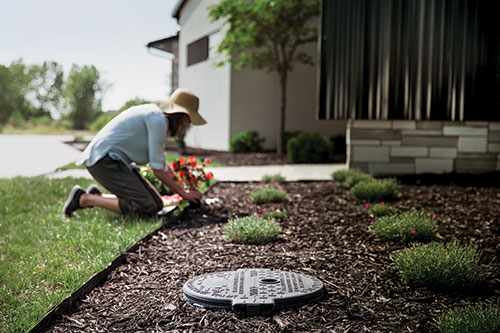How to Choose a Propane Tank

Propane provides real benefits when used in new home construction, remodels or upgrades.
Performance, efficiency and comfort are all qualities that homeowners enjoy from propane appliances. There is also the security of knowing that your energy source is stored on-site and not subject to power outages or curtailments.
A key to ensuring that energy independence is installing the right tank for your home’s annual energy demand. Luckily, choosing the right tank is not difficult.
Choosing the Right Propane Tank for Your Home
Choosing the Best Propane Tank Size
While the average tank size is 500 gallons, the number of propane appliances and their BTU (British thermal unit) rating will determine the size that best meets your needs. If you only have a propane fireplace used to warm a room on chilly days, a smaller tank would be adequate. If you have a large family and more than one furnace, water heater and other appliances, a 1000-gallon tank might be best. Again, your propane supplier can calculate your peak demand, based on anticipated usage and the BTU ratings of the appliances, and suggest a tank size that will serve your family best with the fewest deliveries.
Determining the Correct Location
If you’re building a new home, have your propane supplier and your building contractor walk the site to determine the best location for your tank. The average tank size is 500 gallons, and it will need to meet minimum setbacks from your home or other buildings on the property. Tank placement must also ensure easy access for refilling in all weather. If a driver can safely fill your tank while parked on a plowed road, for example, that would be preferable to the homeowner having to shovel a long driveway to permit a fill. Keep in mind the need to fill your tank when adding gardens, trees or other improvements to your yard.
If you are installing, or may install, a propane-powered backup generator, tank placement to fuel the generator is particularly important. The generator will need to be piped directly from the tank, and not treated as another interior appliance. Installation of the electrical safety equipment (transfer switch) should also be planned to reduce the likelihood of expensive modifications to accommodate it later. Even if a generator is not a part of the original construction, pre-installing piping from the tank, pouring a concrete pad and roughing in space for the transfer switch will save time and expense later.
Above Ground vs. Below Ground
Most propane tanks are located above ground. This is the most common type of installation. However, there are tanks of different sizes that are specifically engineered for underground service. These will have special valving to allow filling and service from one access point that is protected by a cap or dome. Underground tanks require protection from corrosion in the form of special coatings and anodes which are connected at the time of installation. (Note: Above-ground tanks are not designed to be buried!)
Above-ground tanks can be screened or installed on the property to minimize their presence so long as they are not made inaccessible or subject to damage from vehicles. Tanks should be painted a light color to reflect heat. Underground tanks are tested periodically to ensure that the cathodic protection is still working.
Owning vs. Leasing
Most propane tanks are owned by the propane supplier which has the responsibility of maintaining the equipment to ensure safety. That’s why Missouri law does not allow anyone other than the owner to fill, evacuate or move a tank that does not belong to them without the owner’s permission. When a propane company places a tank on your property, that represents a sizable investment in your continued safety and satisfaction with its service.
For that reason, most propane companies will offer a variety of plans designed to meet the needs of their customers: pre-buy, budget-pay, automatic delivery or other programs that will ensure your uninterrupted supply. We recommend that you take advantage of any automatic delivery programs as this will avoid the time and expense of running out of propane. These interruptions of service require, by national codes, a leak test on the system before it is returned to service. If the propane company causes an interruption of service by missing an automatic delivery, they are expected to assume that cost. If the customer is a “will-call” customer who only allows the tank to be filled when they ask, they will be responsible for the cost of the test.
Some customers own their own tanks and do not have a regular supplier. This may result in some savings by shopping several providers for lower prices, but also puts the homeowner at risk during times of heavy demand or tight supply. If you are not a regular customer of any company, there is no guarantee or obligation that a provider will have gallons for you if bad weather accelerates demand. You will also be liable for the maintenance and upkeep of the propane tank, and there are few if any qualified professionals (except those who work for propane companies) who can fix those problems.
Convert to Propane
If you’re thinking about expanding your use of propane, converting to propane for new appliances or switching to propane as your primary energy source, please contact your local propane company to learn more about your options.